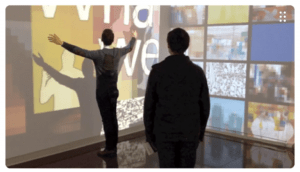Our project, “A Curricular Design Community for Broadening Participation through Computing in the Arts” (CUE-1935143), aims to develop a community of universities and colleges, centered on Computing in the Arts (CITA). CITA is an interdisciplinary Bachelor’s degree program, developed at the lead institution with earlier NSF funding, which integrates core computer science with art theory and practice.
Why
A six-year longitudinal study at the lead institution shows that CITA attracts a different student population than does a traditional CS degree program: it attracts and retains almost twice as many female students, and it graduates 45.6% women compared to the 19% national average in CS. These results are consistent with findings at other institutions.
CITA curricula have been shown to attract a new, diverse population, including retaining and graduating significantly larger numbers of women. Moreover, by combining art and computing, this curricular approach enhances creativity, design skills, and innovation potential. In this age of social media, immersive and digital art, ubiquitous computing, and new transformative computer-based systems awaiting discovery, this project may have a significant cultural and economic impact on our nation and society.
What
This project aims to redefine how to teach computer science to students who approach computing from a broader and more diverse set of interests than typical in most programs. These students are not traditional computer science majors but, instead, students who will follow their interests to apply computing to fields as diverse as fine arts, humanities, political science, music, writing, social science, and history, among others. There are many decades of deep integration between arts and technology from which to draw inspiration for new curricular frameworks.
The primary objective is to create an educational community consisting of diverse institutions, which will be poised to develop effective Computing in the Arts (CITA) degree programs.
Graduates of these CITA programs will create, design, and code new tools for artistic creativity. From contemporary music-, art- and theater-production, to creating new forms of animation, digital media, and games, to invigorating the visual and audio systems of tomorrow’s computers, to inventing revolutionary networked applications, the work students do in these collaborative programs will prepare them for computing-aware, productive, and integrated careers in the information and arts economies.
While the project concentrates on computing and the arts (e.g., art, music, dance, sculpture, theater), this approach in curricular integration is general and can apply across many fields.
How
We will assemble representative Art+CS teams from departments of computer science, art, music, dance and theater at each institution, establish regular online inter-school meetings, and hold at least two meetings at different schools during the grant period to bring the teams together.

An earlier project combining motion capture, interactivity, music, and visual art which our joint, telematic, multi-institution CITA performance project extends (supported in part by NSF DUE-1044861).
To strengthen this multi-institutional community, a concrete synthesis activity will be carried out —
a joint, telematic, real-time, four-institution CITA performance project, which will involve students, faculty, and necessary resources to combine motion capture, audience participation, dance, music, and visual art.
By collaborating on a real, significant art project, all faculty from participating institutions can learn how to work together, jointly use computing and art vocabulary and processes, and get to know each other as we build. By building a project together we should experience what we expect our students to do, and better forge the working community for our eventual work on curricular design.
Upon completion of this activity, the assembled team aims to be ready to develop Curricular Guidelines for CITA degree programs, to broadly disseminate successes, lessons learned, and methods for broadening participation across the nation, with concrete student and potentially transformative social outcomes.
Community Members
The following faculty are currently part of our community, and have contributed to the on-going CS+Art development project:
- Erik Brunvand, Computer Science, University of Utah
- Roger Eastman, Computer Science, University of Maryland
- Cy E Keener, Art, University of Maryland
- Ha Na Lee, Film and Media Arts, University of Utah
- Erin Leigh Butcheck, Dance, College of Charleston
- Bill Manaris (PI), Computing in the Arts, College of Charleston
- Marian Mazzone, Art History, College of Charleston
- Renée McCauley (co-PI), Computer Science, College of Charleston
- Brandon Morse, Art, University of Maryland
- Erica Mott, Dance, Art Institute of Chicago
- Erin Parker, Computer Science, University of Utah
- Huaishu Peng, Computer Science, University of Maryland
- Jan Plane, Computer Science, University of Maryland
- Susan Reiser, Computer Science, University of North Carolina, Asheville
- Courtney Starrett, Visualization, Texas A&M University
- Wendy Wischer, Art & Art History, University of Utah
- William Bares, Computer Science, Whitman College
